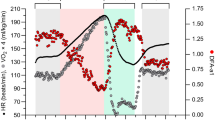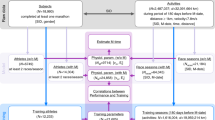Summary
This paper examines the problems of modelling bivariate relationships when repeated observations are recorded for each subject. The statistical methods required to test for a common group model were introduced using an example from exercise physiology, where the oxygen cost of running at four different speeds was recorded for a group of 30 recreationally active males. When data for each subject were studied individually, both the plots and correlations suggested the relationship to be linear. Hence, the homogeneity of the subjects' regression lines was compared using the appropriate ANOVA test. The analysis revealed a significant difference in the slopes and intercepts of the lines, thus precluding the use of a single linear model to represent the group. If the subjects were divided into two groups according to the median maximum oxygen consumption (ie), a multivariate analysis of variance of the slope and intercept parameters helped to explain some of this heterogeneity (P<0.05). However, for physiological rather than statistical reasons, it was necessary to re-analyse the data without the fourth running speed. The revised analysis suggested that the subjects' lines would be better modelled with a common slope but separate intercepts. As before, by dividing the subjects into two groups according to the median\(\dot V{\text{O}}_{{\text{2max}}}\) score, a simplet-test indicated that differences in the subjects' intercept parameters were not significant (P=0.08). Notwithstanding the relatively homogeneous nature of the 30 subjects in terms of\(\dot V{\text{O}}_{{\text{2max}}}\) the statistical methods showed that differences in running economy are, to some extent, dependent on\(\dot V{\text{O}}_{{\text{2max}}}\).
Similar content being viewed by others
References
Bransford DR, Howley ET (1977) Oxygen cost of running in trained and untrained men and women. Med Sci Sports Exerc 9:41–44
Conley DL, Krahenbuhl GS (1980) Running economy and distance running performance of highly trained athletes. Med Sci Sports Exerc 12:357–360
Costill DL (1979) A scientific approach to distance running. Track Field News
Costill DL, Fox EL (1969) Energetics of marathon running. Med Sci Sports Exerc 1:81–86
Costill DL, Winrow E (1970) A comparison of two middle-aged ultramarathon runners. Res Q 41:135–139
Costill DL, Branam G, Eddy D, Sparks K (1971) Determinants of marathon running success. Int Z Angew Physiol 29:249–254
Costill DL, Thomason H, Roberts E (1973) Fractional utilization of the aerobic capacity during running. Med Sci Sports Exerc 5:248–252
Daniels J, Oldridge N (1971) Changes in oxygen consumption in boys during growth and running training. Med Sci Sports Exerc 3:161–165
Daniels J, Krahenbuhl G, Foster C, Gilbert J, Daniels S (1977) Aerobic responses of female distance runners to submaximal and maximal exercise. Ann NY Acad Sci 301:726–733
Davies CTM, Thomason MW (1979) Aerobic performance of female marathon and male ultramarathon athletes. Eur J Appl Physiol 41:233–245
diPrampero PE, Atchou G, Bruckner J-C, Moia C (1986) The energetics of endurance running. Eur J Appl Physiol 55:259–266
Dill DB (1965) Oxygen used in horizontal and grade walking and running on treadmill. J Appl Physiol 20:19–22
Dressendorfer RH, Scaff Jr, JH, Wagner JO, Gallup JD (1977) Metabolic adjustments to marathon running in coronary patients. Ann NY Acad Sci 301:466–483
Fellingham GW, Roundy ES, Fisher AG, Bryce GR (1978) Calorie cost of walking and running. Med Sci Sports Exerc 10:132–136
Hagen RD, Strathman T, Strathman L, Gettman LR (1980) Oxygen uptake and energy expenditure during horizontal treadmill running. J Appl Physiol 49:571–575
Holder RL (1985) Multiple regression in hydrology. Institute of Hydrology, Wallingford
Hopkins P, Powers SK (1982) Oxygen uptake during submaximal running in highly trained men and women. Am Correc Ther J 36:130–132
Jakeman P, Davies B (1979) The characteristics of a low resistance breathing valve designed for the measurement of high aerobic capacity. Br J Sports Med 13:81–83
Kollias J, Moody DL, Buskirk ER (1967) Cross-country running: treadmill simulation and suggested effectiveness of supplemental treadmill training. J Sports Med Phys Fitness 7:148–154
Margaria R, Cerretelli P, Aghemo P, Sassi G (1963) Energy cost of running. J Appl Physiol 18:367–370
Matthews JNS, Altman DG, Campbell MJ, Royston P (1990) Analysis of serial measurements in medical research. BMJ 300:230–235
Mayhew JL (1977) Oxygen cost and energy expenditure of running in trained runners. Br J Sports Med 11:116–121
McConnell AK, Semple ESG (1989) Ventilatory sensitivity to CO2 at rest and during exercise in endurance-trained and non-endurance-trained humans. J Physiol (Lond) 412:39
McMiken DF, Daniels JT (1976) Aerobic requirements and maximum aerobic power in treadmill and track running. Med Sci Sports Exerc 8:14–17
Nevill AM, Copas JB (1991) Modelling errors in motor performance using Generalized Linear Models (GLMs). J Mot Behav 23:241–250
Pugh LGCE (1970) Oxygen intake in track and treadmill running with observations on the effect of air resistance. J Physiol (Lond) 207:823–835
Shepherd RJ (1969) A nomogram to calculate the oxygen-cost of running at slow speeds. J Sports Med Phys Fitness 9:10–16
Svedenhag J, Sjodin B (1984) Maximal and submaximal oxygen uptakes and blood lactate levels in elite male middle- and longdistance runners. Int J Sports Med 5:255–261
Taylor HL, Buskirk E, Henschel A (1955) Maximal oxygen intake as an objective measure of cardiorespiratory performance. J Appl Physiol 8:73–80
Van der Walt WH, Wyndham CH (1973) An equation for prediction of energy expenditure of walking and running. J Appl Physiol 34:559–563
Williams C, Nute LG (1983) Some physiological demands of a half-marathon race on recreational runners. Br J Sports Med 17, No. 3, 152–161
Williams EJ (1964) Regression analysis. Wiley, Chichester, pp 129–161
Author information
Authors and Affiliations
Rights and permissions
About this article
Cite this article
Nevill, A.M., Cooke, C.B., Holder, R.L. et al. Modelling bivariate relationships when repeated measurements are recorded on more than one subject. Europ. J. Appl. Physiol. 64, 419–425 (1992). https://doi.org/10.1007/BF00625060
Accepted:
Issue Date:
DOI: https://doi.org/10.1007/BF00625060




